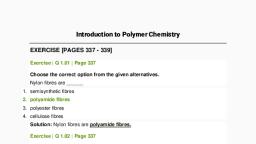Page 1 :
Ex:, , HIGH POLYMERS, , , , Polymer:, A polymer is a large molecule, made up of small and simple molecules joined together, chemically through covalent bond to form one giant macromolecule., , or, Polymers are the substances consisting of giant or macromolecules made by linking a large number of, smaller molecules (monomers)., Polymer is a molecule formed by joining of thousands of smaller molecular units together by chemical, bonds., , A chemical process that leads to the formation of polymer is known as polymerization., , Functionality: The functionality of a monomer is defined as the number of bonding sites present, , in a molecule of a monomer., , The number of bonding sites (or) reactive sites or functional groups present in the molecule, , Example:, , = All double bonded compounds like CH2=CH)? are bifunctional, i.e. have a functionality of two, = Similarly glycols (OH-CH2-CH2-OH), adipic acid (HOOC-(CH2)4-COOH) bifunctional, , = Phenols have their 2,4,6 positions as active sites, hence they are trifunctional., , Degree of Polymerization: The number of times the unit is repeated in a chain is called as, Degree of Polymerization. High polymers have a high degree of polymerization and hence large, molecular masses., , Molecular weight of a polymer = Molecular weight of repeating unit - Degree of Polymerization, , Polymerization:, , Definition: “The process in which the simpler molecules combine together to form very large, molecule having high molecular weight is known as polymerization”. The molecule is, known as polymer., , Types of Polymerization Process:, , Polymers can be synthesized by the following polymerization processes., I. Addition polymerization (or) chain polymerization, , II. Condensation or step polymerization, , Addition Polymerization or Chain Polymerization:, , The polymerization reaction in which a rapid self-addition of several bifunctional monomers to, each other, takes place by chain reaction without the elimination of any by-product is called, “Addition or Chain polymerization”., , The product has the same elemental composition as the monomer compounds containing reactive, double bonds, like alkenes undergo chain polymerization. Addition polymerization is initiated, using small amounts of substances called ‘initiators’., , n [CH2 = CH2] —»-CH»2 — CH2-CH» —{[ CH3-CH2], -CH2 — CH2-CH) —, , Condensation Polymerization Or Step Polymerization:, A polymerization reaction in which a bi- or poly functional monomer undergoes intermolecular, condensation with another bi- functional monomer having a suitable functional group resulting in, continuous elimination of by-products (of small molecules like H2O, HCl, NH; etc) is called, “condensation or step polymerization”., These reactions are normally catalyzed by acids or alkali, n HOOC-(CH3)4 ~COOH + n 2HN-(CH2)s-NH2 ——* fHN-(CH2)¢-NHOC-(CH2)s -CO}, +2n H,O, , Adipic Acid Hexamethylene diamine Nylon 66
Page 2 :
Polyurethane polymers: Polyurethanes are characterized by the presence of Urethane, linkage,, , [-NHCOO-] in their repeat units. They resemble polyamides in their structure, with the presence, , of one more ‘O’ making the chain more flexible. They are linear polymers with the structure, , represented by:, , [- C-NH-(R)-NH-C-O-(R)-O-]n, l l, oO oO, , Polyurethanes are prepared by the addition polymerization reaction between alkyl di-isocyanate, with diol. During addition the H atom of the OH group gets attached to N-atom to form NH— CO, group as follows:, nO=C=N-(R)-N=C=O + nHO-(R)-OH tert. Amine, Alkyl di —isocyanate diol, [- C-NH-(R)-NH-C-O-(R’)-O-],, ll ll, oO oO, , , , Poly urethane, , Properties:, Polyurethanes are spongy, transparent linear thermoplastics. They have low melting point and high, degree of flexibility. They are resistant to water, oil, and corrosive chemicals., , Applications:, , e Due to their resistance to oil , grease and corrosive chemicals, polyurethanes are used in, tire treading and industrial wheels., Polyurethane fibers are used in light -weight water repellant garment like swim suits., Polyurethanes are abrasion resistant and hence they are used as floor coating of, gymnasium, dance floors, etc., Polyurethane foams (U foams) are used in cushions for furniture and car upholsteries., The abrasion resistance and superior adhesion properties of polyurethane adhesives have, enabled the advancement of recording densities in the form of magnetic binders for, various forms of recording media from audio/video tapes, computer disc, and even, prepaid cards and transportation tickets., , ¢ Due to polyurethane’s electrical insulation characteristics, they are also used extensively in, wire coatings and optical fiber cable.
Page 3 :
POLYMER COMPOSITES:, , Combination of two or more structurally different components combine to form a new class of, material suitable for structural applications is referred as composite material. When one of the, components is a polymer, the resulting composite is called a polymer composite., , Fiber reinforced composites are strong and light weight. They are stronger than steel, with less weight and hence they can be used in automobiles to achieve fuel efficiency and less, pollution. They finds higher strength per unit weight, low cost of fabrication and resistant to, corrosion., , Polymeric composites are produced by suitably bonding a fiber material with, polymer resin matrix and curing the same under pressure and heat. Alternate layers of resin, and fiber are laid in a similar sequence to get the desired thickness. The polymer matrixes, generally used are epoxy resin, Phenolic resins, silicone resins, melanine resins etc. The fibers, used are glass fiber, carbon fiber and Kevlar., , Lagenat, Yesian matrioe, , , , Kevlar (Aramid):, It is synthesized from the monomers 1,4-phenylene diamine (para phenylene diamine) and, terephthaloyl chloride through a condensation reaction with the liberation of HCI as byproduct., , " 8 f, a, nad © Dente Eko pbc ote Pee, H, , 1,4-phenylene diamine terephthaloy! chloride Kevlar or Poly = (para-phenylene, terephthalamide), , It is high strength due to presence of inter chain hydrogen bonds formed between carbonyl group, and NH group. Additional strength is achieved from aromatic staking interactions between, adjacent strands. Kevlar is a synthetic fiber stronger than steel., , Molecular structure of Kevlar, dashed line indicates hydrogen bonding, , Properties:, High tensile strength, high chemical inertness, very low coefficient of thermal expansion,, flame resistance, high impact resistance, low weight., , Uses: used as inner lining for tires to prevent punctures, used in table tennis, tennis, badminton, and squash racquets, cricket bats, hockey sticks, used in personal armor such as helmets, ballistic, face masks, bullet proof vests etc. It is often used in the field of cryogenics for its low thermal, conductivity and high strength. Used in boat hulls, helicopter blades etc.
Page 4 :
Conducting polymers:, An organic polymer with delocalised 7-electron system, having electrical, conductance of the same order of a conductor is called conducting polymer., , = This is one of the simplest chain polymers it possesses conjugated double bond., , A® ASR AS, OS AS AS, * Conducting polymers are obtained generally by doping (Doping is either the addition of, electrons (reduction reaction) or the removal of electrons (oxidation reaction) from an, organic polymer with conjugated backbone (consisting of alternating double and single, carbon-carbon bonds., , In a conjugated system, as the electrons are only loosely bound, electron flow may be, possible. However as the polymers are covalently bonded the electrons are localized and do, not take part in conductivity. Hence the material needs to be doped for electron flow to, occur. Once doping has occurred, the electrons in the pi-bonds are able to "jump" around the, , polymer chain. As the electrons are moving along the molecule, electric current occurs., , H sf H, eRe TR ie tu oe, Sa ., Poly cre etylene e a as, ye et phe, wy nr =, See Noe, a, , nt N eos, “a, Palin Keg Re, H, , Polyaniline:, , Distilled 0.2M aniline dissolved in pre cooled 1M HCI solution and maintained at sc., Calculated amount of 0.5M(NH4)2S2Os(oxidizing dopant) dissolved in 1M HCI is added, slowly to above prepared solution. Since the polymerization reaction is exothermic, to maintain, temperature of 0 to 5°C the reaction vessel is placed in ice bath. After the complete addition of, (NH4)2S2Ox the mixture is stirred for about two hours. Polyaniline finally precipitates in the, green form. The dark green precipitate was washed with IM HCI until the green color, disappears. Polyaniline in undoped state is a semiconductor with conductivity 10°S/em., Different oxidation states of polyaniline are., , y=1 Leuco emeraldine, , y=0.5 Emaraldine base, , y=0 Pernigraniline, , Emaraldine base consisting of equal proportions of amine(-NH-) and imine(=N-) sites. On, protonic acid doping, imine sites are protonated by acids to form bipolaron bands., , 4 44, pecm, a, if ih ‘ 4 = 4, , Applications:, , Used as electrode material for commercial rechargeable batteries, used as conductive, tracks on printed circuit boards, used in light emitting diodes, in fuel cells as the electro, catalytic materials, used as sensors and biosensors in glucose sensing for medical, applications and amine sensing for environmental and food safety applications.
Page 5 :
PLASTICS AC.93, , , , , , , , , Factors Influencing the Conductivity of Organic Polymers :, he conductivity of organic polymers is influenced by various factors. These, are briefly discussed below :, (a) Conjugation length of the polymer chain : With the increase in the extent of, ation ina given polymer, its conductivity increases., Doping level : Generally with increase in the doping level of the polymer,, , ivity is found to increase but after some time, it becomes saturated., , CONnQULE, (c) Temperature : In contrast to metals, the conductivity of conducting polymer, 's found to increase with increase in temperature. At some high temperature,, conductivity becomes constant., (a) Frequency of current : The conductivity of these materials also depend on tl, frequency of current because the transport mechanism of most of these materials, , hopping.









































